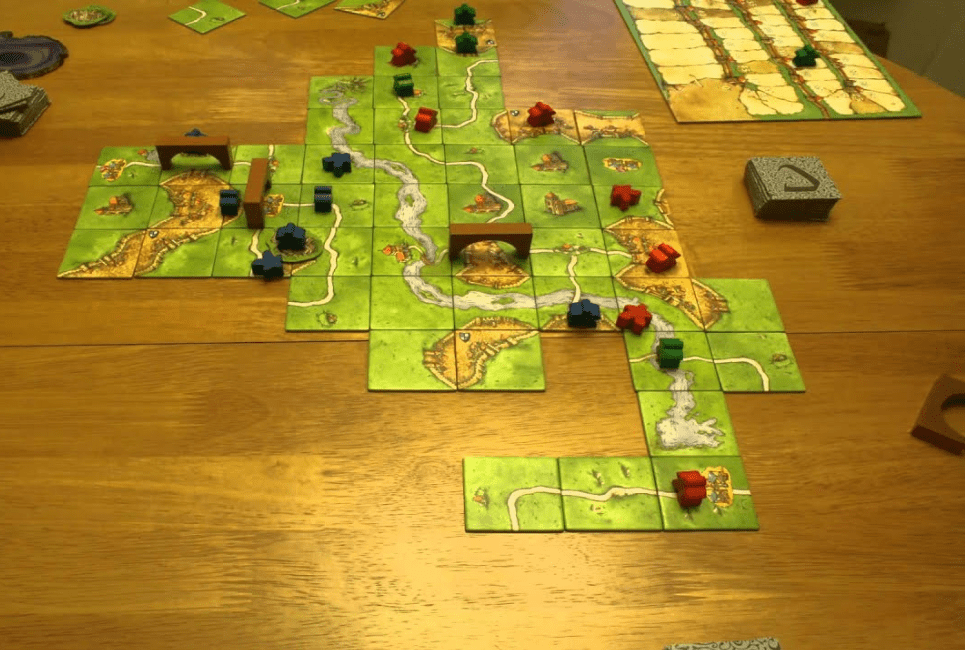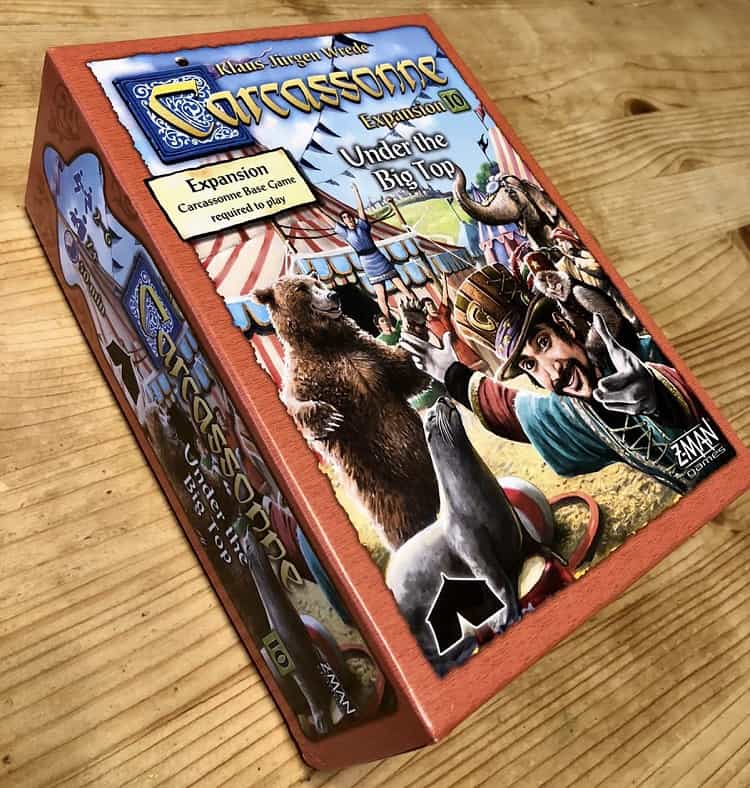My friends, my other half, and I love Carcassonne. It’s our go-to game.
In fact, our close friends are so interested in it that they flew there for a weekend trip and took photos to mirror the box art.
Yes. We’re cool.
Carcassonne genuinely is an excellent game for all the family. It’s enjoyable as a two-player game but still feels balanced with five or more people.
Adding expansions is one way to keep the game interesting. Of course, you’ll need the base game first.
Best Carcassonne Expansion Up Front
Inns and Cathedrals is my top generic recommendation for any Carcassonne player looking for their first expansion.
It takes the original game and expands upon it rather than changing anything drastically. But it allows for more in-game twists, and that’s why it’s my pick as the best.
Expansion Advice and Recommendations
A mixture of large and mini-expansions can be added, and each adds something different to the game.
For example:
- Enjoy playing aggressively against other players? You might enjoy expansions like The Princess and the Dragon or The Mage and Witch.
- Relish jumping into other people’s structures? You might enjoy The Catapult, The Prince and King, or Flying Machines (mini-expansion).
- You’ll appreciate Under the Big Top or The Gold Mines if you enjoy scoring many points.
My point is that each expansion brings a different aspect to the base game. What works for you?
The River and The Abbott

Some expansions are included with the base game when you buy Carcassonne. They’ve become so absorbed into the norm that they’re often forgotten as expansions.
These are The River and The Abbot. Because they’re typically included, I won’t rank them in this list.
- The River brings a new way to start the game with a larger structure from which to place your tiles. This instantly allows more room to build, rather than everyone working from one initial start tile.
- The Abbot introduces the first new meeple to play with: the Abbot. It can be placed in monasteries or gardens and scores like a Monk. However, the Abbot can be taken back if no other meeple is placed that turn (a massive advantage).
Anyway, I’m sure you’re familiar with Carcassonne. Let’s branch into the wild, wacky, dramatic, and experience-altering expansions to mix things up a bit!
What Makes a Good Carcassonne Expansion?
The best expansion will always be down to personal preference, to some extent. You and I might disagree.
For example, it depends on how many people participate in your usual games, how you enjoy scoring points, and how complicated you like to make games.
There are so many factors to make picking the best Carcassonne expansion hard. The aspects below represent my list – what I’m looking for based on my experience.
Personally, I feel the essence of Carcassonne is its simplicity. I want to be able to relax with family and friends, and I look for expansions that mirror and expand upon that.
- How much fun is it? – I suppose that’s the most crucial factor in any game. If we enjoy it, we play it. If not, we don’t. I imagine you’re in the same boat.
- The number of players – most expansions can be played with any number of players. But some are better with five or six, so we rarely play them.
- Playstyle encouraged by the expansion – sometimes, I don’t enjoy the playing style you need to adopt to win. A tactical aspect is always fun, but unnecessary aggressive confrontations can make games a little tense.
- How much extra time you’ll need to invest – this is usually listed on the box and, in our experience, is often accurate.
- I like a simple expansion – that is, one that doesn’t require too many steps or too much extra brain power. I usually play with my other half after we finish work over a cuppa. I’m already tired – I don’t want to plan six steps per turn and have the game take three hours.
A Quick Note on Mini-Expansions

All the mini-expansions (there are technically 26 available) worth getting are included in the Big Box. They change the game a lot less than the larger expansions (surprising, I know!).
Aesthetic mini-expansions change tile appearances but don’t alter gameplay at all.
I enjoy Gold Rush. It feels like a valuable way to compete for points. Or there’s the Flying Machine expansion, which allows you to join uncompleted structures.
In general, mini-expansions are a more controlled introduction to the cutthroat backstabbing of some of the larger versions.
Large Carcassonne Expansions Ranked
There are ten official large expansions for Carcassonne. Here’s how I rank them.
The Catapult
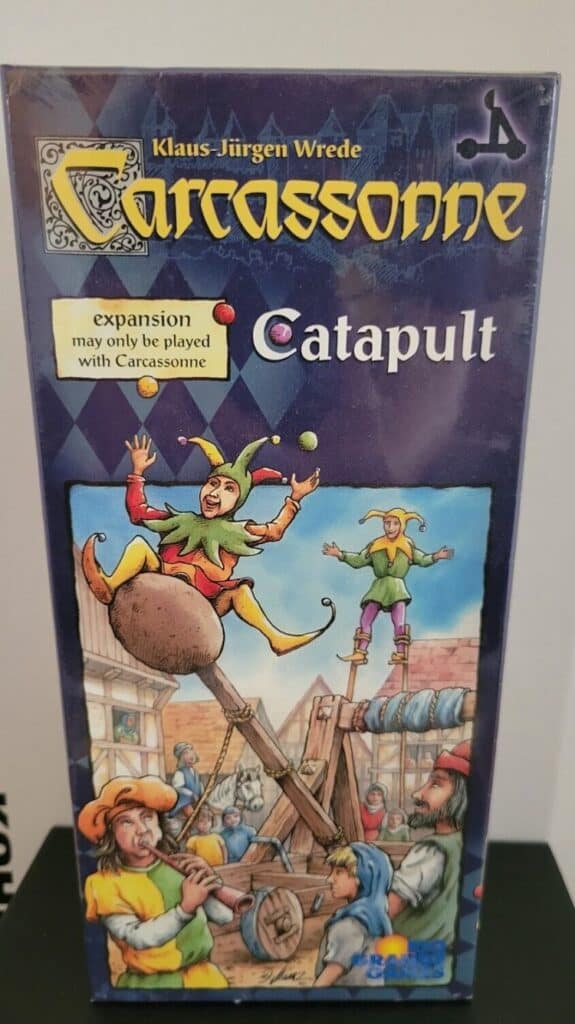
2008 – Expansion #7
This is the most elusive expansion. I’ve struggled to locate it anywhere, even on Z-Man games. I’ve found a listing on Amazon, but it’s costly.
The Catapult is more of a novelty than the previous large expansions and has caused massive division between fans. Broadly, it appears to be about 20% for and 80% against. Those who enjoy standard Carcassonne will consider it sacrilege.
The Catapult comes with a literal catapult to launch your meeple into structures. Yes. You physically toss them. It allows you to join other cities.
I’m not a fan of the idea.
Pros
- You can have fun launching pieces.
- Want to get your kids into board games? Start here.
Cons
- It’s a skill-based expansion – so the more practiced you are, the more significant your advantage.
- It’s hard to get hold of.
- You might lose your meeple if launched too far.
- It adds very little tactically.
Bridges, Castles, and Bazaars
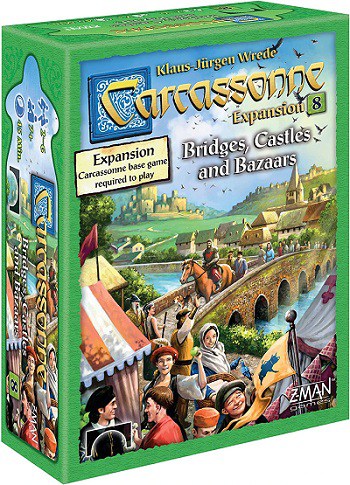
2010 – Expansion #8
This expansion works similarly to the abbey tile in the Abbey and Mayor expansion.
Each player receives two or three Bridges (depending on the number of people playing). Bridges can be placed along with a tile to continue an otherwise-ending road.
Each player is also given the same number of Castles, which can be played when you finish a small city of two tiles. Place the Castle instead of scoring the points, leaving your meeple in place for now.
Castles score points when a neighboring structure (within the two tiles on the left or right) is completed. It doesn’t matter if it only consists of opponents’ meeples.
The final addition is bazaars. Revealing a bazaar option means you take the same number of tiles as there are players and act as an auctioneer. Opponents then bid on these by paying you their points.
The auctioneer can also purchase a tile by subcontracting from their own score. Be careful! You can only win one bid per round.
Pros
- The bazaars add something entirely different from the base game.
- If you like a complete, pretty map, this expansion allows gaps to be filled easier.
Cons
- Going into negative points makes scoring more challenging to track.
- Castles can be frustrating for all parties playing.
- Bridges feel like they make roads too easy, allowing them to be completed so meeples can be returned.
The Tower
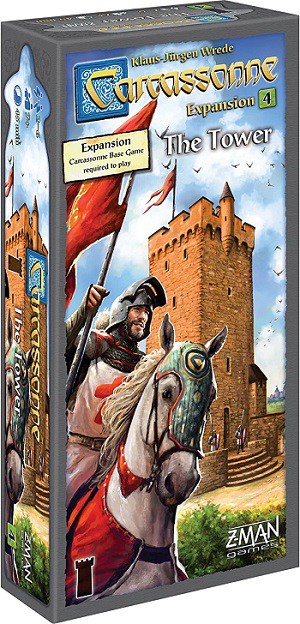
2006 – Expansion #4
If you think The Princess and the Dragon (below) might ruin friendships, wait ’til you hear about The Tower.
The Tower expansion comes with new actions when you place a Tower tile. Place your meeple, as usual, or:
- Play a Tower piece on any empty tower tile, or
- Add to a Tower anywhere on the board, or
- Place your meeple on top of any open tower.
When a Tower piece is played, you may capture a meeple (yours or an opponent’s) on a tile adjacent (but not diagonal) to that Tower. A second layer allows your reach to be two tiles from the Tower, and so on.
Placing a meeple on a Tower stops it from being added to. It won’t gain any points but can still be caught.
Captured opponent meeples may be exchanged for three points – that is, they lose three, and the capturing player gains three.
I feel this is a more balanced expansion than The Princess and Dragon. Still, I rank it lower because, comparatively, much less is added. And it doesn’t work as well with other expansions.
Pros
- A softer but still competitive expansion.
- This expansion works better when playing with more than two players.
- It stops players leeching off your structures as often – but they might just steal them instead of taking your meeple hostage.
- Fewer additional rules to remember when playing.
Cons
- Taking your tiles from the tower distributor doesn’t add anything to the game.
- It might cause upset, moving further away from the more laid-back pace of classic Carcassonne.
Hills and Sheep
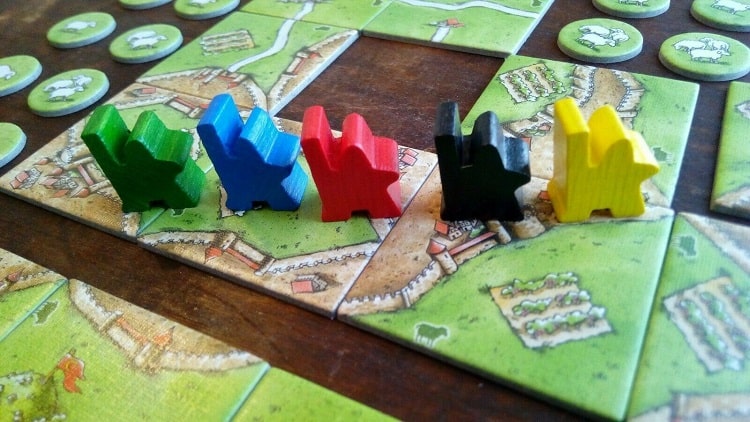
2014 – Expansion #9
If you’ve played Quacks of Quedlinburg and thought Carcassonne could use some similarities, this is the expansion for you.
Each player gains a special meeple – a Shepherd. The Shepherd is placed on a field tile, and a token is drawn from a bag. If it’s a Sheep token, it’s added to the Shepherd’s flock. If it’s a Wolf, return the Shepherd to the player.
When adding a tile to the field with your Shepherd, you may do one of two things:
- Draw another token (risking the Wolf), or
- Score the Shepherd and his Sheep.
You score one point per sheep in the flock. You can still place a meeple on the placed tile.
When a Hill is drawn, you immediately place another tile face-down underneath it without looking. The Hill makes your meeple more valuable than others competing for the structure by winning any ties.
Vineyard tiles basically work as bonus points for monasteries. When adjacent, each counts as three bonus points (if the monastery is completed).
Pros
- A not-too-complex expansion that boosts points.
- The monasteries are made more valuable again.
- The Shepherd makes players start thinking about fields from early in the game, meaning they aren’t only relevant toward the end.
- The Hills negate the advantage of tile-counting, as it’s impossible to know which tiles are left.
Cons
- There’s a push-your-luck element you might not enjoy.
- The expansions seem less creative than previous expansions.
Princess and the Dragon
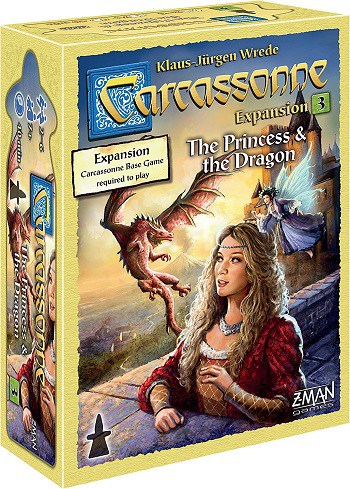
2005 – Expansion #3
This expansion divides many players. It adds a level of conflict to Carcassonne with the cutthroat Dragon piece.
The Dragon can remove meeples when moved, which happens when a tile with a dragon symbol is played. Each player then takes turns to move the Dragon one tile at a time (going clockwise from the player who placed the piece). It starts from the volcano tile where the Dragon ‘resides’.
It moves a maximum of six spaces (one per player) and cannot return to a tile landed on in this sequence. You’ll find a list of pieces the Dragon ‘eats’ and returns to the owner and a separate list of those that aren’t removed.
The Fairy keeps a tile immune from the Dragon’s attack but must be moved when a volcano tile is placed.
There are also tiles with a Princess symbol. When you play one of these in a city, you may remove a Knight from that city. This is great when competing for ownership.
There’s one more new symbol – the Magic Portal. When you place one of these tiles, you may put a meeple down on it or any previously placed Magic Portal (as long as you follow standard placement rules).
A less vicious option is the Flying Machines mini-expansion. This at least brings an element of chance and risk if you want to join an already-owned structure.
Pros
- It can vastly change the game.
- You can ensure That-Overly-Competitive-Person (we know who you are) doesn’t always win when you play with them.
Cons
- The same You-Know-Who is more likely to throw a fit and storm off, meaning you don’t finish a game.
- It is brutal to work on a structure and have all your meeples removed with no way to protect yourself.
- A complex expansion, especially when used with others.
Under the Big Top
2017 – Expansion #10
This is the newest expansion we have added to our collection. It introduces many new ways to score points and a new meeple: the Ringmaster. We’ve enjoyed playing this one, but it changes the game and adds a more prominent chance element.
You’ll find one Big Top piece. This is placed on a circus tile (straw circles). Under the Big Top, you put a random animal token face-down. It’ll have a value of between one and seven points.
The Big Top is moved on when the next circus tile is placed. Reveal the animal token on the now-uncovered tile. Score by multiplying this value by the number of adjacent meeples.
You might gain an awful lot of points this way. Then again, the animal might be the flea (one point), making your investment a significant waste of time and resources.
The Ringmaster meeple works like a normal meeple, except when scored, it gains an additional two points per adjacent circus or acrobat tile.
The acrobat tiles allow your meeples to have a new role: Acrobats. Up to three Acrobats can be placed onto these tiles (one at a time, per adjacent tile) as a pyramid. The third stands on the shoulders of the other two.
The Acrobat pyramid is completed if a tile is put down and a meeple isn’t played. The rules don’t mention that this tile must be adjacent to the Acrobats, so we treat it like the rules for the Abbot.
Pros
- Lots of points can be scored.
- The new meeples and roles are simple and fit nicely with the base game.
Cons
- Increases the chance element – you might use a lot of meeples and score very little, or the Big Top might move away quickly.
- Acrobats are an unnecessary addition to meeple roles. They’re better in games with more players, but in smaller games, they seem surplus.
Abbey and Mayor
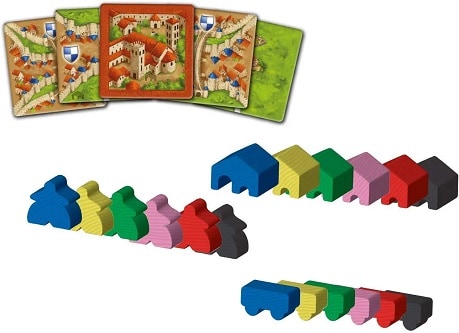
2007 – Expansion #5
This expansion adds more complex pieces, with three new ones per player.
The Mayor is a meeple that you can only play in city pieces. It counts for one meeple per coat of arms (shield) in the city.
For example, if there are three coats of arms, it’s worth three meeples. Equally, it could be worth nothing if there were no coats of arms.
The Barn is a piece that can be placed to score Farmers (all players’ not just yours) immediately before removing them from a field. The Barn then limits any Farmers connected to it – all affected players receive only one point per completed city rather than three.
At the end of the game, the Barns also score four points per completed city. The catch? You may only place one on the corner of a tile touching three fields.
But wait – it gets more complicated! You also receive a Wagon token. This can move immediately from a completed structure to another incomplete and unoccupied one on an adjacent tile.
In addition, each player receives one abbey tile at the start. It’s a bordered tile that works like a monastery. You may put this down to fill a hole – as in, it must be surrounded and match the adjacent structures. Place the abbey instead of drawing a tile.
Pros
- Adds new tactics and results in more thinking and planning per turn.
- You’re less likely to have meeples stuck on structures the whole game.
- The Mayor is a good piece that makes battling for cities more gripping.
Cons
- It removes the ability to trap meeple as easily (which is essential in a two-player game).
- The abbey tile makes things too easy. It’s an aesthetically-pleasing solution to save your meeple from a problematic situation. Boo.
- The Barn and Wagon pieces are more complex than other expansions – and a bit too fiddly.
- The game takes longer – you need to do much more each turn.
Count, King, and Robber

2008 – Expansion #6
This is really a collection of mini-expansions. It includes The King and Scout, The Cults, The River 2, and The Count of Carcassonne. You can play with all these or pick and choose which ones you want.
We liked this one specifically as the Count expansion includes a specific starting tile – it’s literally a little map of the real-life old city of Carcassonne. This brings more diversity to the start of your game.
The cult tiles work like the monasteries, except they compete to be completed if placed adjacent to another monastery. Only the first to be finished will score any points.
The King and the Robber mean that whichever player finished the largest city and road (respectively) scores one point for each completed city or road at the end.
The Count expansion was the one that took the longest to get our heads around. It works by putting your meeple in the City of Carcassonne when you finish a structure for which another player gets points, but you do not. When another is completed elsewhere, you can move all the ‘banked’ meeples into it.
However, the Count can be transferred to lock meeple in an area of the City of Carcassonne. As a result, they’re stuck until he’s moved. See? Complex! (If it helps, think of the Count as a bit like the Robber in Catan, but without the stealing.)
Effectively, you’re encouraged to complete other players’ structures so you can bank meeples to be ‘cashed in’ later.
Pros
- It contains many elements that can be added individually or together.
- Only minimal changes to the game.
- Encourages completion so more meeples are available to players.
- Adds diversity to playstyles with the combination of different elements.
Cons
- The Count expansion takes some getting used to – and may cause upset if you suddenly jump an army of meeples into someone’s structure they worked hard to finish.
- The King and Robber can rack up many points in a larger game, so if more people play, I’ve found there’s often a significant scoring difference between winners and losers. This can result in people giving up early and just playing as if they have to. I call this the Monopoly Effect.
- The River and City of Carcassonne cannot be played together. You have to pick which tiles to start with.
Traders and Builders

2003 – Expansion #2
Traders and Builders comes in at #2. It adds new layers to the existing game without dramatically changing the format, with two new meeples: the Builder and the Pig. The focus is around completing structures.
Traders and Builders brings city tiles with ‘resources’. These resources are worth points at the end of the game if you have the most of one type. This changes the gameplay in an intriguing way because only the player that completes the city takes the resources, regardless of whether they have the majority of meeples in the structure.
The Builder meeple allows players to take an extra tile when they work on a structure their Builder is on. The Pig makes the Farmers worth more points per completed city at the end of the game.
Pros
- Not too complex.
- You feel rewarded by completing and working on structures.
- Like other expansions, it gives more variety in tiles. This stops your meeple from getting permanently trapped, although it’s still possible.
Cons
- The Pigs make an already powerful meeple (Farmer) even stronger; it can be placed whether or not someone else has claimed that field.
- It’s easy to forget to give out tokens for resources – causing issues at the end of the game.
Inns and Cathedrals
2002 – Expansion #1
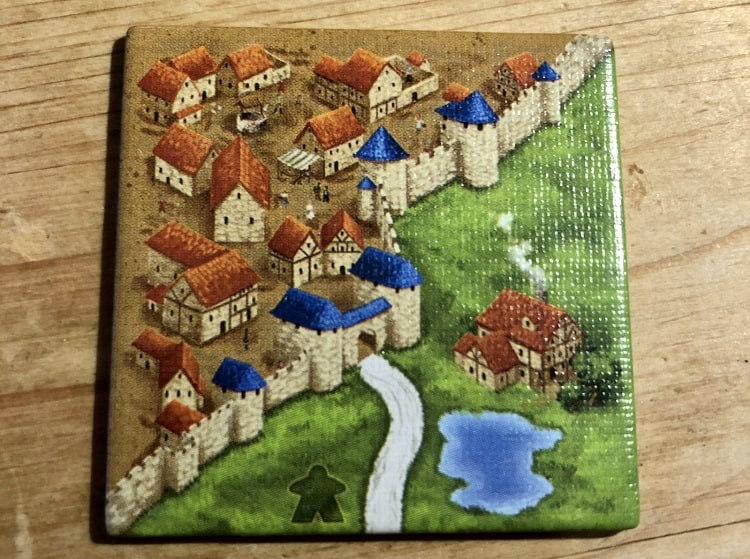
Here we are! My top pick. Inns and Cathedrals adds the inn and cathedral tiles (no surprises there!), more meeples (for six players), and the large meeples.
Inns and Cathedrals was the first large Carcassonne expansion ever released. It changes the base game minimally, with 18 new tiles and a large meeple each.
The expansion brings what I feel was missing from the base game; a way to play more defensively or aggressively (depending on your preference).
It makes roads more valuable: adding an inn tile to your road doubles its value if completed. After playing Carcassonne for a while, you realize roads are the worst structures. They take so long to be completed, and after all that, they’re only worth one point per tile. This expansion makes them worth competing for.
The cathedral tiles make the cities more valuable. They must be surrounded entirely by city pieces. If the wall is completed, you receive three points per tile rather than the usual two.
However, if either of these structures is incomplete, they receive no points at the end of the game. High risk, high reward!
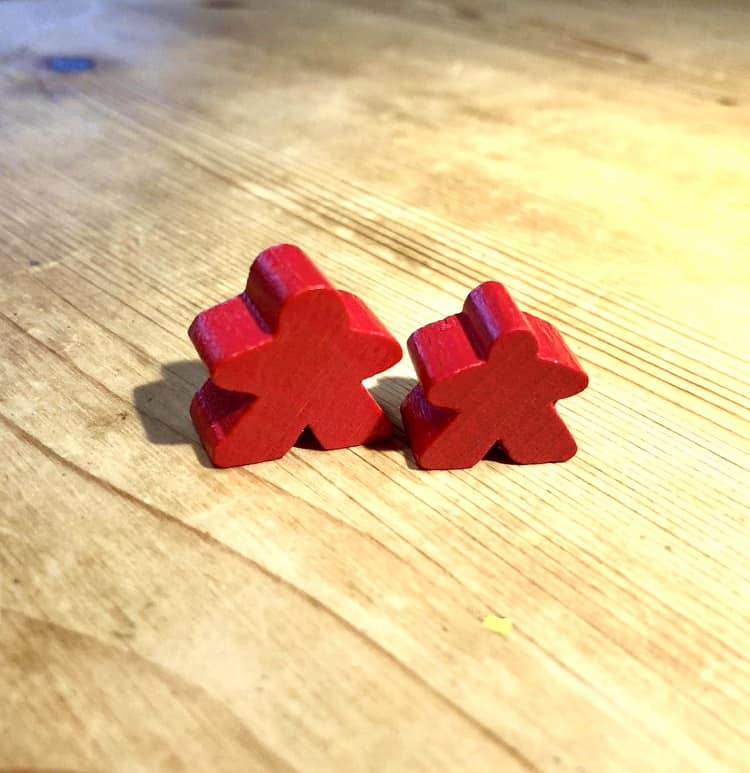
Inns and Cathedrals also brings new meeples, which is part of the reason I feel it’s the best expansion. You get a pink set of meeples (so you can now play with six people) and a large meeple (worth two standard meeples) each.
Plenty of games have been taken by sneaking in a large meeple as a Farmer in the last few tiles, causing much upset, a couple of strops, and several death stares.
Inns and Cathedrals is my favorite Carcassonne expansion because it enhances the base game without changing it too much. There’s little to remember and no additional steps to be taken each turn. Hence, it continues with that classic Carcassonne vibe of being easy to pick up and play.
Even if you don’t enjoy the additional tiles, the extra meeples make this a worthwhile expansion.
Pros
- Stays most faithful to the base game.
- Makes roads worth competing for.
- The big meeple allows more strategic competition.
- The risk/reward feels balanced.
- You can play the base game with the big meeple, leaving the rest of Inns and Cathedrals off to one side.
Cons
- After using this version, you’ll struggle to return to the base game.
Frequently Asked Questions
Question: Can You Play the Large Carcassonne Expansions by Themselves?
Answer: No, you need to add them to the base game. If you don’t have the base game, you must go out and get that first. Consider getting a Big Box bundle, which includes quite a few expansions.
Question: Can You Play Multiple Expansions at Once?
Answer: Yes, each expansion instruction booklet contains information about how it is affected by others. As you mix and match, you’ll notice some work really well together, whereas some clash.
Bear in mind that each one will increase the time needed to play. Unless you have a spare six hours, stick to two large expansions rather than all ten!
Question: Where can You Find the Expansions’ Instruction Manuals?
Answer: All the instruction manuals are available online from the Z-Man games website.
Conclusion
Here’s my TL; DR.
Carcassonne expansions dramatically vary each game, giving it so much more replayability. Each one adds something different.
I like all the Carcassonne expansions (except The Catapult, which I’ve never played or heard of before!). But the best one depends on who I’m with, my mindset, and what time it is.
If you’ve never bought an expansion, I couldn’t recommend Inns and Cathedrals enough. It feels the most well-rounded and could have easily been included in the base game along with the River and the Abbot.
It’s just what Carcassonne stands for: straightforward (but tactical) fun.
The Big Box
If you still need to get Carcassonne, I recommend purchasing the Big Box version. It comes with eleven expansions. The 2022 version is available, but you’ll have to search around for the elusive original.
It’s the most cost-effective option. For us, it was cheaper to buy the Big Box rather than the base game and just one expansion. Keep an eye on the price, as it does fluctuate.
Also, ours was cheaper in Spanish, but you can get all the English manuals online. The tiles themselves are all imagery, so the language doesn’t matter!
Recommended reads:
- Carcassonne Board Game Guide: Competitive Map Building
- The Best Board Games of All Time
- How to Find the Best 6 Player Board Games
- 25 Words or Less Board Game Guide
- Terraforming Mars Guide: Fighting for Spaces in Space - April 22, 2023
- Zathura Board Game Guide - April 20, 2023
- Ark Nova Guide – Zoo Complex, Or Complex Zoo? - April 8, 2023

